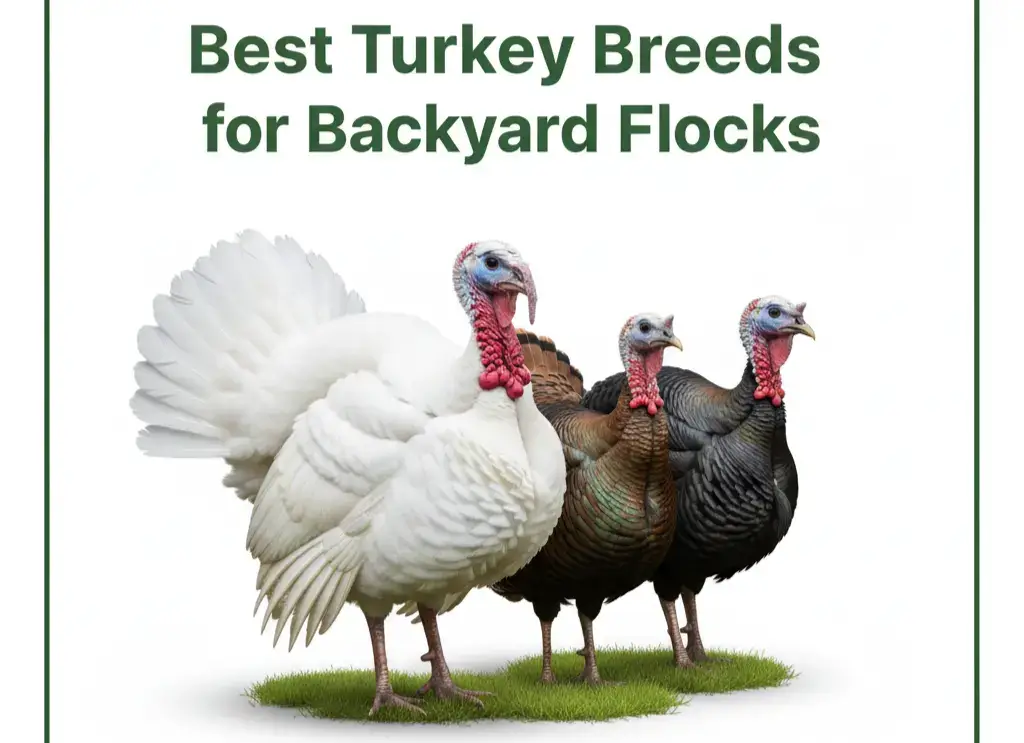Choosing the right turkey changes everything. Space stays tidy, kids stay safe, and dinner tastes better. I wrote this guide to share what works in a real backyard, not just on paper.
I focus on calm temperaments, smaller spaces, good meat, and natural breeding. This is where heritage turkeys shine. Broad Breasted types grow fast, but they need more care.
I keep it simple, with tips for space, feed, and predator safety that fit busy lives. If you are hunting for the best breed of turkey for backyard flock, you are in the right spot. I will share my top breeds for 2025 and a simple care plan that gets you from day one to harvest.
How I choose the best breed of turkey for a backyard flock
I start with a checklist. It keeps me honest and saves money.
First, I pick between heritage and commercial turkeys. Heritage birds mate on their own, forage well, and live longer. They grow slower, but they are tougher and easier to manage. Broad Breasted turkeys, like the White, pack on breast meat fast. They often need closer oversight. If you want repeat hatches with less fuss, heritage is the safer path. For a fast Thanksgiving bird, Broad Breasted can fit, if you plan to process early.
Second, I match the breed to my space and housing. A small yard can still work. I use a dry coop, tight fencing, and a roomy run. Ten to twenty square feet per bird in the run is my baseline. More space means less fighting and cleaner feathers. Roosts go 18 to 24 inches high, so birds can hop up without straining legs.
Third, I weigh temperament and noise. Calm birds turn chores into joy. I handle poults often, which builds trust. One tom is plenty for a small flock. Extra toms argue, and nobody needs that near a patio.
Fourth, I set a clear purpose. Meat, eggs, or breeding. For meat, I plan processing around 24 to 28 weeks with many heritage birds. For eggs, I expect a modest spring and summer lay. For breeding, I stick with heritage birds that mate naturally and show good mothering.
If you want a primer on picking types for a small lot, this guide on selecting a turkey variety for small or backyard flocks lays out the basics well. For a straightforward comparison of growth and care needs, I like this resource on comparing heritage and production turkeys.

Photo by Mark Stebnicki
Heritage or commercial, and why it matters
Heritage turkeys breed on their own, have sturdy legs, grow slower, and forage like champs. They live longer and handle pasture better. Broad Breasted Whites grow fast and carry big breast meat. They cannot mate naturally, and they face higher risks of leg and heart issues. They eat more and need more oversight. My rule: if I want easy care and repeat hatches, I pick heritage. If I want a big bird fast and I plan to process early, I consider broad breasted.
Space and shelter: how much room turkeys need
I aim for 10 to 20 square feet per bird in the run. More if they free range. Nights belong in a dry, draft-free coop with clean bedding. Roosts at 18 to 24 inches keep legs safe. Outside, I set shade and wind breaks.
Tight fencing blocks dogs and raccoons. If hawks are common, I use a covered run or netting. Water stays clean and close to the roost. More space means calmer birds and tidier feathers.
Temperament, noise, and family friendly traits
I look for calm, curious birds that accept handling. Toms strut and show off, so I favor breeds with steady temperaments. I start with young birds and handle them daily.
Turkeys like company and bond with their flock. One tom per small group is usually enough. A gentle flock reduces stress for kids, pets, and neighbors.
Purpose: meat, eggs, or breeding your own poults
Set your purpose first. For meat, I want steady growth and good feed conversion. Many heritage birds hit a nice table size at 24 to 28 weeks. For eggs, I expect a modest season, mostly spring through summer.
For breeding, I pick heritage birds that mate naturally and show good mothering. If I want the full cycle, I choose a breed that sets well and raises poults with little help.
Best turkey breeds for backyard flocks in 2025: my top picks
These breeds earn their keep in small flocks. They are hardy, keen foragers, and easier to manage day to day. You get flavor, temperament, and a bird that fits a real yard.
Narragansett: calm, hardy, and great for beginners
Narragansetts are quiet workers. Pros include a very calm nature, good pasture skills, solid mothering, and flavorful meat. Cons include slower growth than commercial birds. Expect typical maturity near 28 weeks.
They handle mixed weather and regular handling without drama. If I want a breed that can raise the next generation and stay steady around kids, this is my first pick.
Bourbon Red: rich flavor and strong foragers
Bourbon Reds win on taste. Pros include standout flavor, hardy bodies, and eager foraging that trims feed costs. They feel tough and disease resistant in a backyard setting.
Cons include slower growth and a smaller carcass than Broad Breasted birds. Plan on 26 to 28 weeks for a good table size. Their deep red color makes them easy to spot at a glance, handy in tall grass or brush.
Midget White: small size with good meat yield
Midget Whites fit small lots without giving up meat. Pros include a compact body, decent meat yield, and above average egg production for a turkey. They are easy to handle and calm.
Cons include limited availability, so poults can sell out fast. They suit a small family that still wants a full freezer. White feathers also make processing cleaner looking.
Jersey Buff: gentle, good layers, friendly backyard bird
Jersey Buffs bring a soft touch to a small yard. Pros include a mild temperament, decent seasonal egg laying, and smart foraging. Cons include a need for strong predator protection, since they can be curious.
Meat leans mild and tender. The medium growth rate fits a patient backyard plan. If I want a calm flock and a few extra eggs, this one makes sense.
If you have experience and want variety, Blue Slate and Royal Palm also perform well in managed backyards. They are heritage types with good foraging and classic looks. For availability snapshots and variety comparisons, I browse hatchery pages like Heritage Turkeys at Meyer Hatchery.
Simple care plan for backyard turkeys: setup, feed, and health
I keep the plan tight and repeatable. It works for heritage birds in small spaces and scales up as you learn.
Brooding poults the first four weeks
Use a safe brooder with dry bedding and a steady heat source. I start at about 95°F the first week, then drop 5°F each week. Set a warm zone and a cool zone so poults can self regulate.
Offer a high protein turkey starter and clean water. I add marbles or stones to the waterer for the first days, which keeps tiny heads safe. Check for pasty vents and clean gently if needed.
Daily feed and pasture plan that saves money
Start with a 28% protein starter for the first weeks. Shift to a grower at 20 to 24% as they feather out. Add grit once they start eating greens or bugs. Keep fresh water out at all times.
Give safe pasture time to cut feed costs, then bring birds in before dusk. Treats are fine, but keep them under 10 percent of the diet. Simple habits here save real money.
Predator proofing and space that keep birds safe
Use sturdy fencing that a dog cannot push through. I like electric netting for moves around the yard. If hawks are active, add a covered run or netting. Lock birds in a dry, draft free coop at night.
Check for gaps and loose boards. Store feed in metal cans to block rats and raccoons. Plan for 10 to 20 square feet per bird in the run, and more if you can.
Health checks, breeding, and when to process
I do a quick check at feeding. Eyes bright, legs sound, breathing clear, droppings normal. Watch weight and posture. Heritage birds breed on their own. I keep one tom for 6 to 10 hens.
For meat, many heritage birds hit a good table size at 24 to 28 weeks. Broad breasted types grow faster, but they need closer care for legs and hearts. A simple routine keeps birds thriving.
Conclusion
Pick a turkey that fits your space, family, and goals. My top backyard choices are Narragansett, Bourbon Red, Midget White, and Jersey Buff. Blue Slate and Royal Palm also suit experienced keepers who want variety.
If you want the best breed of turkey for backyard flock, match your goals to a calm, hardy bird and keep the setup simple. Start small, learn the birds, and enjoy the process. Ready to begin? Choose your breed today and set up the brooder.


